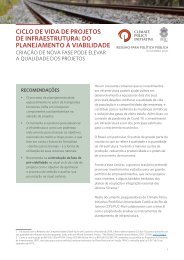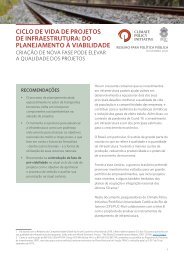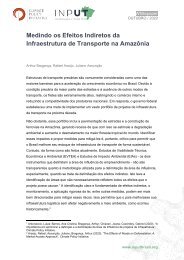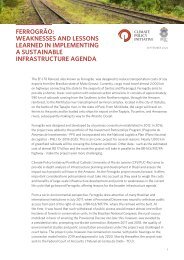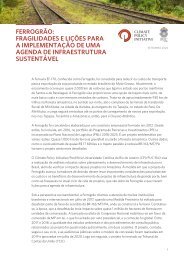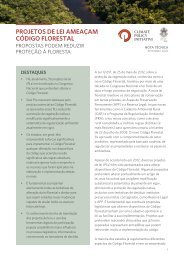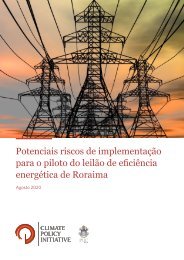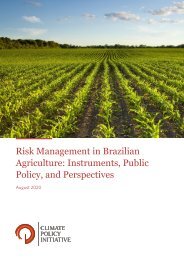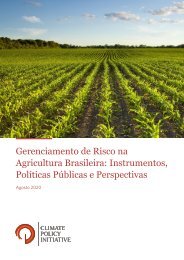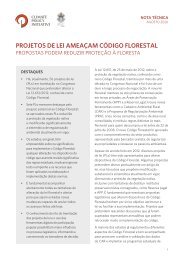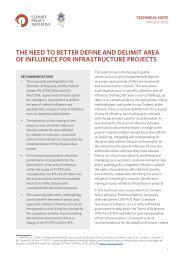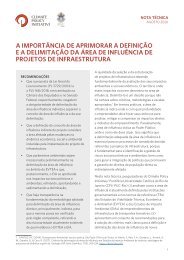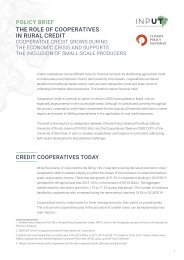Targeting Deforestation, Boosting Regeneration
You also want an ePaper? Increase the reach of your titles
YUMPU automatically turns print PDFs into web optimized ePapers that Google loves.
NOTES<br />
DATA SOURCES<br />
The analysis explores a rich spatially explicit (raster) dataset built from a variety of publicly available sources. The key<br />
variables and their corresponding sources are: georeferenced secondary vegetation cover from TerraClass Amazônia<br />
(INPE and Embrapa); georeferenced deforestation alerts from DETER (INPE); and georeferenced deforestation<br />
increments from PRODES (INPE). The technical paper provides additional details.<br />
METHODOLOGY<br />
The analysis investigates the potential relationship between law enforcement targeting primary deforestation and secondary<br />
vegetation from 2004 through 2014. The sample area covers the full extent of the Brazilian Amazon Biome. The unit of<br />
analysis is a 900-meter raster cell, but data are built from raster datasets at the 30-meter resolution. Although satellite-based<br />
panel data on regeneration serve as the basis for dataset construction, panel data are collapsed into a cross-sectional tenyear<br />
difference in secondary vegetation coverage to mitigate measurement error from the time-series variation. Based on<br />
this spatial cross-sectional setup, and using georeferenced deforestation alerts to capture law enforcement, the analysis<br />
tests whether cell-level changes in the extent of secondary vegetation are associated with the intensity of environmental<br />
enforcement in a cell’s surroundings. The estimations include a host of cell-level controls for spatially explicit observables to<br />
address concerns regarding omitted variable bias. Reverse causality is not a primary concern given that regeneration does not<br />
affect enforcement by the design of the Brazilian monitoring system. The technical paper provides additional details.<br />
AUTHORS<br />
Juliano Assunção<br />
Executive Director<br />
Climate Policy Initiative/Pontifical Catholic University<br />
of Rio de Janeiro (CPI/PUC-Rio)<br />
Associate Professor, Department of Economics, PUC-Rio<br />
juliano.assuncao@cpirio.org<br />
Clarissa Gandour<br />
Head of Policy Evaluation, Conservation<br />
Climate Policy Initiative/Pontifical Catholic University<br />
of Rio de Janeiro (CPI/PUC-Rio)<br />
clarissa.gandour@cpirio.org<br />
Helena Rodrigues<br />
Research Analyst, Conservation<br />
Climate Policy Initiative/Pontifical Catholic University<br />
of Rio de Janeiro (CPI/PUC-Rio)<br />
helena.rodrigues@cpirio.org<br />
www.inputbrasil.org<br />
Suggested citation<br />
ASSUNÇÃO, Juliano; GANDOUR, Clarissa; RODRIGUES, Helena. Policy Brief. <strong>Targeting</strong> <strong>Deforestation</strong>, <strong>Boosting</strong><br />
<strong>Regeneration</strong>: Efforts to Combat Forest Clearings in the Amazon Promote Tropical Regrowth. Rio de Janeiro:<br />
Climate Policy Initiative, 2020.<br />
April 2020<br />
The Land Use Initiative (INPUT – Iniciativa para o Uso da Terra) is a dedicated team of specialists who work at the forefront of<br />
how to increase environmental protection and food production. INPUT engages stakeholders in Brazil’s public and private sectors<br />
and maps the challenges for a better management of its natural resources. Research conducted under INPUT is generously<br />
supported by the Norway’s International Climate and Forest Initiative (NICFI) and Instituto Clima e Sociedade (iCS) through grants<br />
to Climate Policy Initiative.<br />
Content licensed under Creative Commons Attribution 4.0 International.<br />
The texts in this publication may be reproduced in whole or in part<br />
provided that the source and the respective authors are cited.<br />
7




